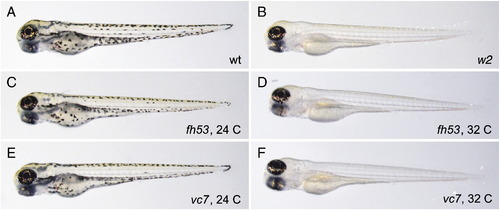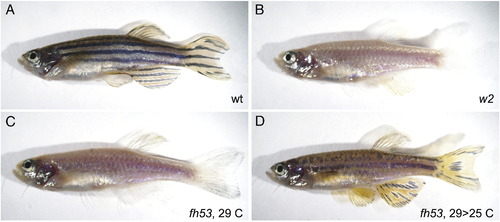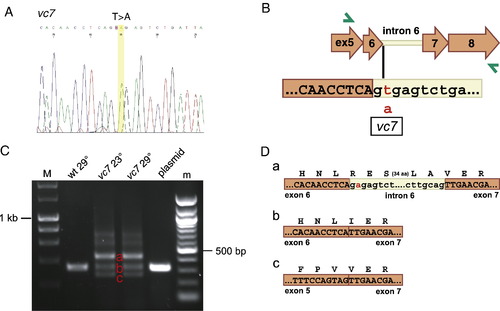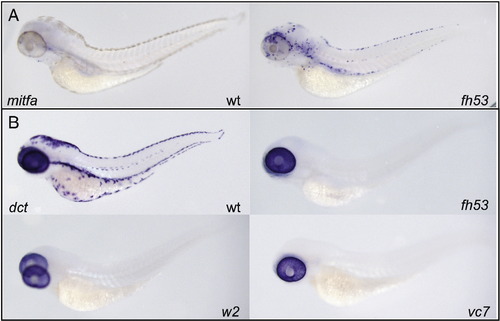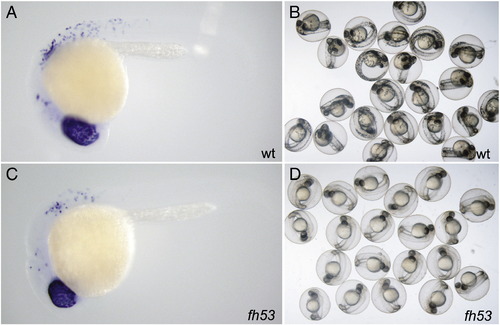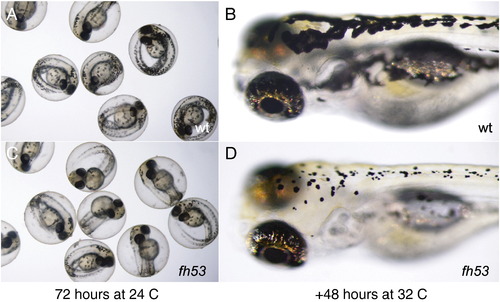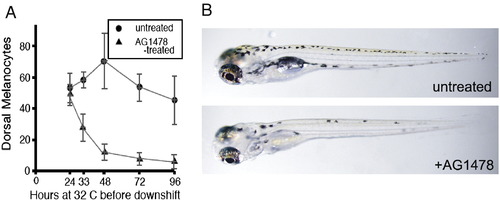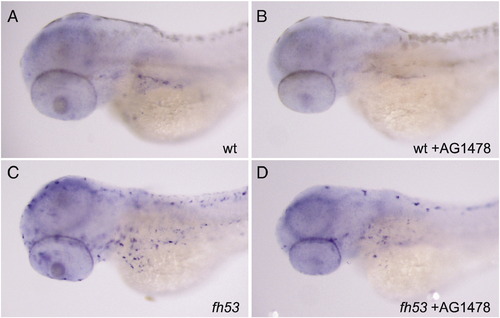- Title
-
mitfa is required at multiple stages of melanocyte differentiation but not to establish the melanocyte stem cell
- Authors
- Johnson, S.L., Nguyen, A.N., and Lister, J.A.
- Source
- Full text @ Dev. Biol.
|
Temperature sensitivity of two mitfa hypomorphic alleles: larval phenotypes. A) Wild-type, B) mitfaw2, C) mitfafh53 raised at 24 °C, D) mitfafh53 raised at 32 °C, E) mitfavc7 raised at 24 °C, and F) mitfavc7 raised at 32 °C. PHENOTYPE:
|
|
Temperature sensitivity of the mitfa fh53 allele: adult phenotypes. A) Wild-type, B) mitfaw2, C) mitfafh53 raised at 29 °C, and D) mitfafh53 raised at 29 °C to adulthood and then shifted to 25 °C for one month, showing recovery of melanocytes. PHENOTYPE:
|
|
The vc7 allele affects spicing of mitfa. A) Electropherogram of sequence obtained from mitfavc7 allele. B) Location of vc7 mutation in genomic sequence. C) Semi-quantitative RT/PCR shows that missplicing is not temperature-sensitive. vc7 results in transcripts that (a) include intron 6 and (c) skip exon 6, in addition to correctly-spliced transcript (b). M, 200 basepair ladder; m, 100 basepair ladder. D) Reading frame is preserved in aberrantly-spliced transcripts a and c. |
|
mitfa is required at multiple steps in melanocyte development. A) mitfa expression persists at restrictive temperature. Wild-type and mitfafh53 larvae are shown. B) No dct is expressed in neural crest cells when held at restrictive temperature, but retinal expression of dct is not affected. Wild-type, mitfaw2, mitfafh53, and mitfavc7 larvae are shown. Embryos were treated with 0.2 mM PTU to suppress melanin synthesis. All larvae are at the equivalent of 82 h at standard temperature. EXPRESSION / LABELING:
|
|
Embryos raised at permissive temperature to dct+ stage, when shifted show no melanized cells. A) Wild-type embryo showing dct expression in retinal pigment epithelium (RPE) and neural crest melanoblasts, B) wild-type embryos 20 h after upshift (stage equivalent to 45 h at standard temperature) showing differentiated melanocytes, C) mitfafh53 embryo showing dct expression at time of temperature upshift, and D) mitfafh53 embryos 20 h after upshift do not display any melanized cells save for RPE. In A and C, embryos were treated with 0.2 mM PTU to suppress melanin synthesis. EXPRESSION / LABELING:
|
|
Loss of dendricity in melanocytes at restrictive temperature. Wild-type and mitfafh53 embryos were raised at permissive temperature for 72 h, photographed (A,C) then shifted to 32 °C for 48 h (B,D). |
|
mitfa is not required in the stem cell, but is required for survival of direct-developing melanocyte progenitors. A) Graph showing dorsal melanocyte number in mitfafh53 homozygous larvae held at 32 °C for the indicated times and then shifted to permissive temperature, and melanocytes counted three days later. B) Homozygous mitfa fh53 larvae held at 32 °C in the presence of DMSO (top) or AG1478 (bottom) then downshifted to permissive temperature. |
|
in situ hybridization for mitfa in wild-type (A,B) and mitfafh53 (C,D) larvae held at restrictive temperature with or without AG1478 treatment from 9 to 48 hour development. AG1478 treatment reduces the number of mitfa-expressing cells in both wild-type and mutant embryos. Larvae are at the equivalent of the 65 hour stage at standard temperature. Embryos were treated with 0.2 mM PTU to suppress melanin synthesis. EXPRESSION / LABELING:
|
Reprinted from Developmental Biology, 350(2), Johnson, S.L., Nguyen, A.N., and Lister, J.A., mitfa is required at multiple stages of melanocyte differentiation but not to establish the melanocyte stem cell, 405-413, Copyright (2011) with permission from Elsevier. Full text @ Dev. Biol.

